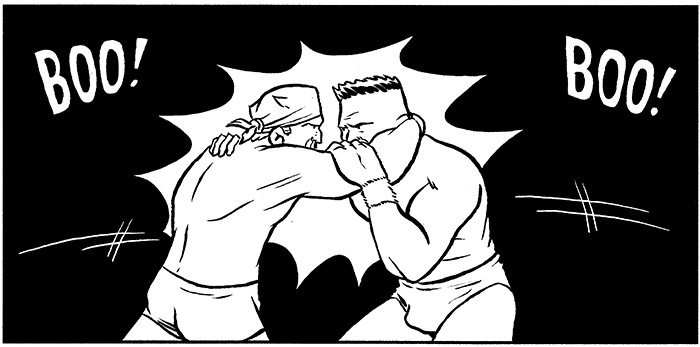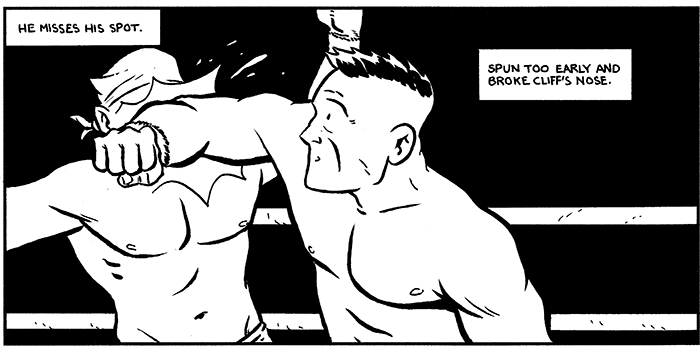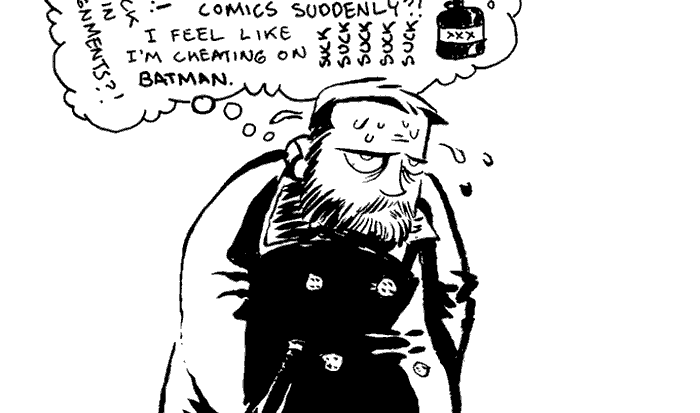Wrestling comics have always been sort of a mixed bag. Historically, they have been terrible. My theory is that “kayfabe” kept wrestling comics from being great stories. I know what you’re thinking (unless you are already a wrestling fan). What on earth is “kayfabe?” Let me give you a brief history of wrestling.
The origins of the term “kayfabe” will never be known for certain. Most experts believe the term started when professional wrestling toured with carnivals. Carny lingo infused into the business. “Kayfabe” means that the portrayal of the pre-determined matches are “real1”. Kayfabe is also its own secret language of terms. It’s meant to keep outsiders, or “marks”, where they belong. On the outside. This is how business ran for years. We “believed” Hulk Hogan had a leg drop that would stun men into submission2.
Peeking Behind The Curtain
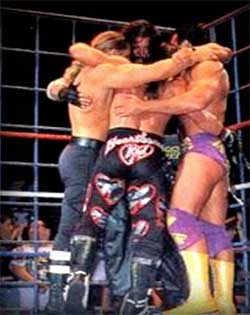 A funny thing started to happen in the mid 1990s. Kayfabe finally started to drop, and fans got a peek behind the curtain. The first major incident occured at Madison Square Garden in May of 1996. Known as “The Curtain Call,” four wrestlers hugged each other after a match. Two of them were leaving to go to another promotion. Yet the problem was the audience saw each pair battle it out in the ring earlier in the night as sworn “enemies.” It was one of the first times that fans had proof that what they were watching wasn’t real3.
A funny thing started to happen in the mid 1990s. Kayfabe finally started to drop, and fans got a peek behind the curtain. The first major incident occured at Madison Square Garden in May of 1996. Known as “The Curtain Call,” four wrestlers hugged each other after a match. Two of them were leaving to go to another promotion. Yet the problem was the audience saw each pair battle it out in the ring earlier in the night as sworn “enemies.” It was one of the first times that fans had proof that what they were watching wasn’t real3.
Soon after in 2000, a popular documentary opened titled Beyond the Mat. It promised a behind the scenes look at professional wrestling. It gave us more than we bargained for. A large segment of the film focused on Jake “The Snake” Roberts. You get to see the beloved former WWE star battle drug addiction and wrestle on the road in bingo halls4. His story went on to become the springboard for The Wrestler, released in 2009. With Mickey Rourke’s heartbreaking performance, the film blew “kayfabe” open for the masses.
Wrestlers Were Real Life Superheroes
“Kayfabe” means the illusion of wrestling was real. And that reality reflected itself in wrestling comics before 2000. With their superhuman physiques, wresters were gods come to life. Or superheroes. But most wrestling comics took wrestlers out of the ring. They became like their comic book counterparts. Heroes who fought crime or had outrageous adventures outside of the ring.
These books were horrible5.
I’m not sure if “kayfabe” was a double-edged sword or not. Once the wrestlers were outside of the ring, it became so unbelievable as the premise for a comic book. They were unreadable. Most people would rather read Batman fight crime than a wrestler.
Enter the Reality Era of WWE
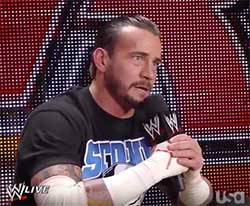 Between 2000 and now, wrestling became meta. You know it’s fake. The wrestlers know that you know it’s fake. And then that became the story. Elements of wrestler’s real lives started to make their way into the ring. This became known as the “Reality Era” in WWE. It kicked into high gear in 2011 with CM Punk’s infamous “Pipe Bomb” speech during an episode of RAW. While in front of live cameras, Punk sits down at the edge of the ramp after interrupting a match. And he gives the WWE universe both barrels. Punk was considered the best wrestler in the world. A reputation built from his years on the independent wrestling scene. He moved to WWE. But since he didn’t look like a typical wrestler, he was “buried.” He flamed the management of the company, all the way to the president, Vince McMahon. Then his microphone lost power and the show cut to commercial. Give it a watch when you can.
Between 2000 and now, wrestling became meta. You know it’s fake. The wrestlers know that you know it’s fake. And then that became the story. Elements of wrestler’s real lives started to make their way into the ring. This became known as the “Reality Era” in WWE. It kicked into high gear in 2011 with CM Punk’s infamous “Pipe Bomb” speech during an episode of RAW. While in front of live cameras, Punk sits down at the edge of the ramp after interrupting a match. And he gives the WWE universe both barrels. Punk was considered the best wrestler in the world. A reputation built from his years on the independent wrestling scene. He moved to WWE. But since he didn’t look like a typical wrestler, he was “buried.” He flamed the management of the company, all the way to the president, Vince McMahon. Then his microphone lost power and the show cut to commercial. Give it a watch when you can.
It was all a “work.” None of it was real. Punk and McMahon worked together on the whole stunt.
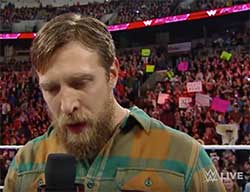 This dynamic played out again with the retirement of Daniel Bryan last week. Bryan was the wrestler most able to take advantage of CM Punk’s trailblazing. He was another indy darling who came to the WWE and was “buried,” but fans loved him. They loved him so much that they were actually able to influence how the company booked him. Which is a bit insane if you think about it. The audience hijacked RAW and propelled Bryan into the main event of Wrestlemania 30. His story culminated with winning the WWE Championship. I watched his rise, week in and week out. It was an amazing time to be a fan.
This dynamic played out again with the retirement of Daniel Bryan last week. Bryan was the wrestler most able to take advantage of CM Punk’s trailblazing. He was another indy darling who came to the WWE and was “buried,” but fans loved him. They loved him so much that they were actually able to influence how the company booked him. Which is a bit insane if you think about it. The audience hijacked RAW and propelled Bryan into the main event of Wrestlemania 30. His story culminated with winning the WWE Championship. I watched his rise, week in and week out. It was an amazing time to be a fan.
Unfortunately, Daniel Bryan’s injuries piled up on his career. With tears in his eyes, he retired to a full arena on live television. And it was just so… real. David Shoemaker wrote an excellent piece about the night that is worth the read. If you want to know more about the history of wrestling, his book The Squared Circle: Life, Death and Professional Wrestling is excellent.
Wrestling is fake. But it’s also very real. The matches are pre-determined, but the people wrestling are incredible atheletes. Athletes with no “off season.” Athletes that get hurt peforming almost nightly. They are always on the road without much of a break. And those stories, those are the ones that are fascinating.
Finding My Way Back To Wrestling
I fell out of love with wrestling the same way I did with Christmas when I discovered Santa Claus wasn’t real. With sudden disgust and resentment. I can’t remember exactly when I realized that wrestling was fake as a young boy. I seem to remember a botched spot involving Paul “Mr. Wonderful” Orndorff. I also remember figuring out the story beats in a match. “Oh, he always loses just like this at this point in the match… wait a second,” my 7 year old mind deduced. Just like in fiction, if the story structure becomes too obvious, it takes you out of the story.
 I came back to wrestling more than 20 years later. I had ignored it for so long that my interest with it came just as immediate as I had lost it so long ago. I read an interview about a local Omaha wrestler, “Mad Dog” Vachon. He reflected on his life on the road and the hardships he faced. It captivated me. I couldn’t let it go. I started picking up wrestler’s autobiographies. Ric Flair’s To Be The Man. “Classy” Freddie Blassie’s Listen Up, You Pencil Neck Geeks! I scoured for every bit of information I could find. Because like it or not, a story was starting to form in my head.
I came back to wrestling more than 20 years later. I had ignored it for so long that my interest with it came just as immediate as I had lost it so long ago. I read an interview about a local Omaha wrestler, “Mad Dog” Vachon. He reflected on his life on the road and the hardships he faced. It captivated me. I couldn’t let it go. I started picking up wrestler’s autobiographies. Ric Flair’s To Be The Man. “Classy” Freddie Blassie’s Listen Up, You Pencil Neck Geeks! I scoured for every bit of information I could find. Because like it or not, a story was starting to form in my head.
Wrestlers of a particular era seemed to share certain traits. A lot of them died young. And they seemed to have terrible personal lives. Either they grew up in a bad household, or they themselves were not good people to live with. Many of them were hardcore partiers. Most of them lived with a decent amount of pain. All of them loved wrestling.
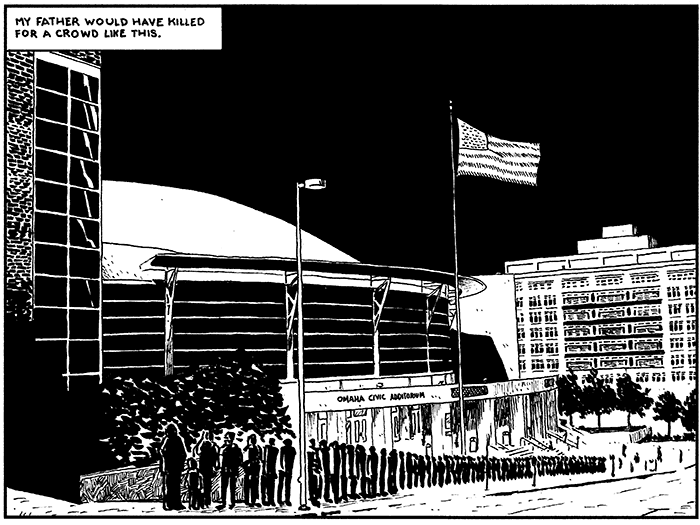
The Omaha Civic Auditorium
“Am I making a wrestling comic?”
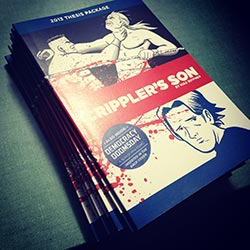 I wanted to create a comic about a wrestler that wasn’t only about wrestling. It was about his family. It was about the little brother he was putting through medical school. It was about his dead father, who was also a wrestler. I wanted it to take place in 1990. And I wanted it to take place in Omaha, which has past roots in wrestling. I took down a lot of notes and made several outlines, but I couldn’t get it to quite work. Oh, also it was 500 pages. It was a sprawling family epic. And I was terrified to actually draw it. I didn’t want to put in 500 pages of work for a wrestling comic. You know, the type of comic that never finds an audience and will remain unseen.
I wanted to create a comic about a wrestler that wasn’t only about wrestling. It was about his family. It was about the little brother he was putting through medical school. It was about his dead father, who was also a wrestler. I wanted it to take place in 1990. And I wanted it to take place in Omaha, which has past roots in wrestling. I took down a lot of notes and made several outlines, but I couldn’t get it to quite work. Oh, also it was 500 pages. It was a sprawling family epic. And I was terrified to actually draw it. I didn’t want to put in 500 pages of work for a wrestling comic. You know, the type of comic that never finds an audience and will remain unseen.
Several years later, I was entering my second year at the Center for Cartoon Studies. I needed a thesis project to graduate. I decided if The Crippler’s Son was going to have a chance to see the world, this was its only one. At least it would have a purpose. It might not find an audience, but it would help me graduate.
The first thing I did was the most important. With the help of some amazing advisors, I whittled the story down to a brisk 50 pages. Five hundred pages was crippling me (pun intended). I did 10 thumbnail drafts during most of my second year to nail the story down right. Then I briskly created the art in a month. I detailed that process back in my post How to Draw a 50 Page Comic in One Month.
I’m happy with the results. The Crippler’s Son was released by Fantagraphics in November 2014. It exceeded my requirements. It not only helped me graduate, it helped me join the ranks of Fantagraphics, a publisher I have admired since my youth. As far as finding an audience, it’s done about what I expected. It was never going to be a smash hit. But the readers who do give it a chance are always impressed by it, and that’s enough for me.
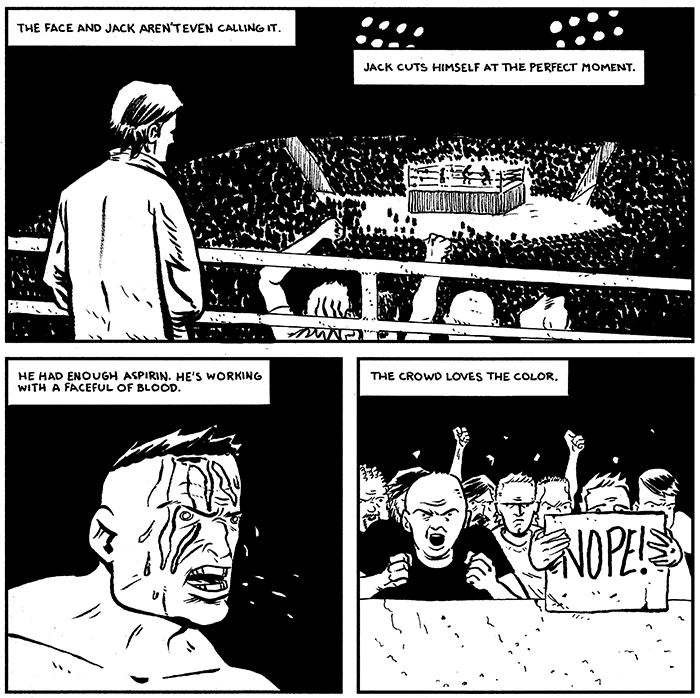
More Wrestling Comics
I’ve started to notice a few more wrestling comics appearing on the stands. I have even thought about going back to the well and creating another one. If the WWE Network had existed even 5 years ago, The Crippler’s Son might have been extraordinarily different. There is just so much information available about the life of wrestling behind the scenes now. It all still fascinates me. I am a regular viewer of NXT, WWE’s development program which has become a brand unto itself. I watch independent promotions now online, looking for wrestlers with great stories and abilities.
Part of me does think about re-making The Crippler’s Son, to go after that 500 page monster I conceived. But I’m going to take a page out of wrestling: if you aren’t getting over, time to try something new. It’s time for some different stories. But you never know. Wrestling waited 20 years for me to come back to it. It’ll be there when I’m ready for another comic.

Note: links to Amazon are affiliate links. If you like what you read, consider supporting my writing by using my links. I get a cut, you get some entertainment.
- As fans, we’re often asked by outsiders, “you know wrestling is fake, right?” Of course we do. That’s the fun of it. ↩︎
- Hogan’s leg drop is my least favorite part of his act by far. “Bruiser” Brody, on the other hand, sold his leg drop as a devestating finisher like his life depended on it. ↩︎
- If anyone is interested, watch the Triple H documentary, Thy Kingdom Come. They talk about it much more extensively there than I’m going to here. The four wrestlers in question were Razor Ramon (Scott Hall), Diesel (Kevin Nash), Shawn Michaels, and Triple H (Paul Levesque). Levesque bore the brunt of the punishment from the incident. ↩︎
- Jake “The Snake” Roberts seems to have found peace from his addictions finally in the recently released The Resurrection of Jake The Snake. I was a big fan of his when I was a boy. I haven’t seen it yet because it’s supposed to be especially poignent, but I will soon. ↩︎
- There are several exceptions of course created by “smart marks.” Check out the Love & Rockets for some excellent wrestling comic storylines. My friends Jason Caskey and Phil Hester also did a genre-bending wrestling comic titled Holy Terror which I adored. ↩︎

